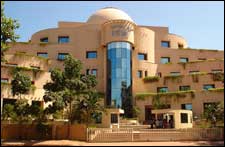 Studies have shown that 75 per cent of the total buildings that will exist in India by 2030 are yet to be constructed. This piece of statistics points to the good news that there is still a lot of potential in India to construct buildings that are green and environmentally sustainable. Use of solar power through design techniques is one of the primary ways in which builders can reduce the energy consumption, says Hitesh Doshi, Chairman & Managing Director, Waaree Energies.
Studies have shown that 75 per cent of the total buildings that will exist in India by 2030 are yet to be constructed. This piece of statistics points to the good news that there is still a lot of potential in India to construct buildings that are green and environmentally sustainable. Use of solar power through design techniques is one of the primary ways in which builders can reduce the energy consumption, says Hitesh Doshi, Chairman & Managing Director, Waaree Energies.
Green construction as a trend has its seeds in the Western corporate world’s emphasis on developing eco-friendly structures. The movement against over-urbanisation began globally in the 1970s but has caught on in India only in the last two decades or so. Green construction involves the use of recycled materials, alternate sources of power and concepts of sustainable design to make buildings more eco-friendly, waste resistant and less dependent on the traditional and fast-depleting natural resources. Green construction also creates residential or work spaces that are healthier and more cost-effective.
While the penetration of green construction in India is still minimal, studies have shown that 75 per cent of the total buildings that will exist in India by 2030 are yet to be constructed. This piece of statistics points to the good news that there is still a lot of potential in India to construct buildings that are green and environmentally sustainable. Use of solar power through design techniques is one of the primary ways in which builders can reduce the energy consumption of households as well as offices. Use of solar power generating equipment’s as well as architectural tricks can reduce the need for, if not eliminate, power-guzzling temperature regulating devices. In places with more sunlight, solar panels deliver an even higher return on investment, which is the case for most parts of our country.
Buildings are major consumers of energy in so far as their construction, operation and maintenance are concerned. It is estimated that almost 50per cent of the global energy demand is due to buildings. Thus, an energy conscious architecture has evolved to address these issues. These Systems are designed with the top of the line engineering & technology to corroborate the green building concept such as Solar BIPV modules, Solar hot water systems, etc.
Essentially, Building Integrated Photo Voltaic (BIPV) refers to photovoltaic cells and modules which can be integrated as part of the building structure, and therefore can replace conventional building materials, rather than being installed afterwards. Solar water heating is one of the most economically attractive applications of solar energy and is widely used throughout the world. These systems are based on very basic engineering principle and dose not involves high degree of engineering. The whole system application is user friendly with almost nil operation maintenance. Solar Water heating systems have found their acceptance in many parts of India and soon they will be an integral part of every urban/ semi-urban building & housing societies.
 Most experts have established that it is only a myth that developing green projects is costlier than regular ones. Most often, the price difference is marginal and is easily recovered through the money saved during subsequent years of usage. The problem, that India faces as does the rest of the world, is that the builder never uses the housing or office projects it builds and therefore the concern for money saved on utility bills hasn’t been a motivating factor for them. However, gradually they too are realizing that besides green construction being the best way to achieve sustainability, it is also a huge draw for customers who want to live healthier and cheaper. Many construction companies are passing on the increased cost of sustainable buildings on to the customers and the latter don’t mind bearing this initial cost in exchange for low maintenance issues.
Most experts have established that it is only a myth that developing green projects is costlier than regular ones. Most often, the price difference is marginal and is easily recovered through the money saved during subsequent years of usage. The problem, that India faces as does the rest of the world, is that the builder never uses the housing or office projects it builds and therefore the concern for money saved on utility bills hasn’t been a motivating factor for them. However, gradually they too are realizing that besides green construction being the best way to achieve sustainability, it is also a huge draw for customers who want to live healthier and cheaper. Many construction companies are passing on the increased cost of sustainable buildings on to the customers and the latter don’t mind bearing this initial cost in exchange for low maintenance issues.
Another factor that is contributing greatly to the momentum that green construction is gathering is that of government policies. To make it cost-effective to fit solar panels, the government is providing subsidies making solar power not just the most environmentally friendly option, but also the most prudent choice. The Ministry of New and Renewable Energy (MNRE), under Dr Farooq Abdullah, has also started a solar building programme. Government initiatives such as this are promoting many institutions like hotels and hospitals to install solar panels.
Corporate have now realised the importance of creating spaces that prevent such pit falls in designs and are increasingly spending on upgrading to green standards to reap long-term benefits. Green buildings use less power and water, thus the cost of living in or operating a workspace out of such buildings is also less. Green buildings can save as much as 30per cent on power consumption every year compared with normal buildings. These buildings also use 40per cent less potable water.
Several big Indian companies have also constructed sprawling campuses with Platinum ratings from international green building councils. These firms see green construction as a way to meet their corporate social responsibility targets and also earn money through carbon credits. Surplus credits (collected by overshooting the emission reduction target) can be sold in the global market. One credit is equivalent to one tonne of carbon dioxide emission reduced. With new solar BIPV modules now there vis possibility of Using solar panels for glass facade, windows and roof top also. Few builders have already started using this along with solar water heaters
There are now over 100 green buildings in India in cities such as New Delhi, Chennai, Hyderabad and Kolkata. The trend is only likely to spiral as more and more real estate developers, owners and architects wake up to the benefits of such construction not just for the environment but also for their own pockets and the larger sustainability concern.











